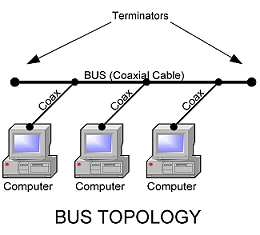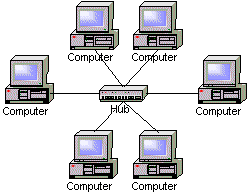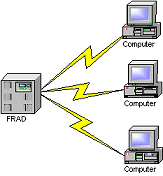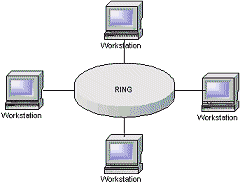
Local Area Networks (LANs) use one of the following designs. These designs are refered to as 'topologies'.
| Topology | Types |
|---|---|
| Bus | (Logical Ethernet) |
| Hub and Spoke (Star) | (Physical Ethernet) |
| Point to Multipoint | Frame Relay |
| Point To Point | Serial |
| Ring | FDDI, Token Ring |

INetworks emplying a bus topology use a common physical connection for communication. That means the physical media is shared between devices. When devices attempt to acess the network bus at the same time, some method must be used to prevent a collision (CSMA/CD). These types of network are most commonly seen with coaxial cable as their physical medum. Token Bus, Ethernet (Thinnet and Thicknet) are common examples of bus topologies.

Please note that this is not called a hub and spoke design because there is a network hub in the drawing. This drawing is to show how a star or hub and spoke network resembles the hub and spokes of a wheel. The Hub and Spoke topology refers to a network topology where there is a central connection point to which multiple devices are connecte. It must be stressed that a hub device is not the only device usable in this configuration. A bridge or switch may also be used. Ethernet utilizing twisted pair is STILL considered a BUS architecture from a logical standpoint, however, physically, an Ethernet network can be wired as a hub and spoke model.
This is not quite the same as a hub and spoke configuration. Whereas in a hub and spoke all devices pass through the hub, a multipoint system can send to one or more systems based on address. Frame Relay is the most common technology to implement this scheme, and it is typically a WAN technology. All the remote points are connected to a single Frame Relay switch or router port, and communication between sites is managed by that central point. In hub and spoke, all spokes or only one spoke hears a given transmission. In point to multipoint, any number of remote stations can be accessed.

Point to Point topologies are simplest and most straightforward. You must picture them as a chain of devices. Your computer can 'daisy chain' a series of serial devices off one of your serial ports. Networks of routers are often configured as point-to-point topologies.

Ring topologies are similar to bus topologies, except they transmit in one direction only from station to station. Typically a ring architecture will use separate physical ports and wires for transmit and receive.
